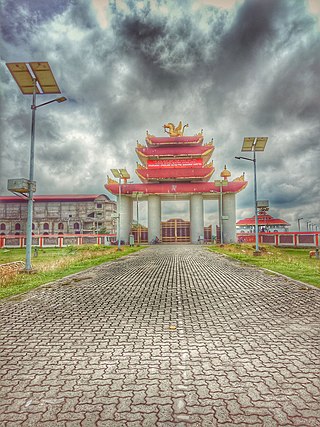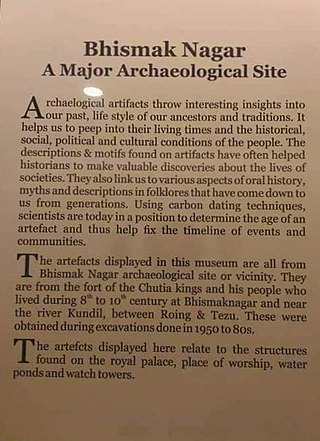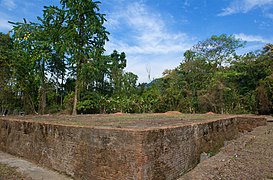
The Ahom or Tai-Ahom is an ethnic group from the Indian states of Assam and Arunachal Pradesh. The members of this group are admixed descendants of the Tai people who reached the Brahmaputra valley of Assam in 1228 and the local indigenous people who joined them over the course of history. Sukaphaa, the leader of the Tai group and his 9,000 followers established the Ahom kingdom, which controlled much of the Brahmaputra Valley in modern Assam until 1826.

The Ahom dynasty (1228–1826) ruled the Ahom Kingdom in present-day Assam, India for nearly 598 years. The dynasty was established by Sukaphaa, a Shan prince of Mong Mao who came to Assam after crossing the Patkai mountains. The rule of this dynasty ended with the Burmese invasion of Assam and the subsequent annexation by the British East India Company following the Treaty of Yandabo in 1826.

Buranjis are a class of historical chronicles and manuscripts associated with the Ahom kingdom. There were written initially in the Ahom Language and later in the Assamese language as well. The Buranjis are an example of historical literature which is rare in India—they bear resemblance to Southeast Asian traditions of historical literature instead. The Buranjis are generally found in manuscript form, a number of these manuscripts have been compiled and published especially in the Assamese language.
Sadiya is a town in Tinsukia district, Assam. It was the capital of the Chutia Kingdom and after the downfall of the kingdom it became the seat of the Sadiya-khowa-Gohain of the Ahom kingdom. Extensive remains of buildings and fortifications built during the rule of the Chutias near Sadiya still point to the importance of the region in the past. Historically Sadiya referred to the Chutiya kingdom which included at times the districts of Lakhimpur, Dhemaji and Tinsukia. It is claimed to be the center of development of the eastern Assamese dialects, the inscription here are written in a Tai script. Its stands on a grassy plain, almost surrounded by forested Himalayan mountains, on the right bank of Lohit River which is locally considered the main stream of the Brahmaputra River. The deepest point of the Brahmaputra River is located near this village. It is famous for a flower named satphul, which is much like Jasmine.

The history of Assam is the history of a confluence of people from the east, west, south and the north; the confluence of the Austroasiatic, Tibeto-Burman (Sino-Tibetan), Tai and Indo-Aryan cultures. Although invaded over the centuries, it was never a vassal or a colony to an external power until the third Burmese invasion in 1821, and, subsequently, the British ingress into Assam in 1824 during the First Anglo-Burmese War.

The Dimasa Kingdom was a late medieval/early modern kingdom in Assam, Northeast India ruled by Dimasa kings. The Dimasa kingdom and others that developed in the wake of the Kamarupa kingdom were examples of new states that emerged from indigenous communities in medieval Assam as a result of socio-political transformations in these communities. The British finally annexed the kingdom: the plains in 1832 and the hills in 1834. This kingdom gave its name to undivided Cachar district of colonial Assam. And after independence the undivided Cachar district was split into three districts in Assam: Dima Hasao district, Cachar district, Hailakandi district. The Ahom Buranjis called this kingdom Timisa.

Suhungmung, or Dihingia Roja I was one of the most prominent Ahom Kings who ruled at the cusp of Assam's medieval history. His reign broke from the early Ahom rule and established a multi-ethnic polity in his kingdom. Under him the Ahom Kingdom expanded greatly for the first time since Sukaphaa, at the cost of the Chutia and the Dimasa kingdoms. He also successfully defended his kingdom against Muslim invasions, first by a general called Bar Ujjir and another by Turbak Khan. During his time, the Khen dynasty collapsed and the Koch dynasty ascended in the Kamata kingdom. His general, Ton-kham, pursued the Muslims up to the Karatoya river, the western boundary of the erstwhile Kamarupa Kingdom, the farthest west an Ahom military force had ventured in its entire six hundred years of rule.

The Ahom kingdom was a late medieval kingdom in the Brahmaputra Valley that retained its independence for nearly 600 years despite encountering Mughal expansion in Northeast India. Established by Sukaphaa, a Tai prince from Mong Mao, it began as a mong in the upper reaches of the Brahmaputra based on wet rice agriculture. It expanded suddenly under Suhungmung in the 16th century and became multi-ethnic in character, casting a profound effect on the political and social life of the entire Brahmaputra valley. The kingdom became weaker with the rise of the Moamoria rebellion, and subsequently fell to repeated Burmese invasions of Assam. With the defeat of the Burmese after the First Anglo-Burmese War and the Treaty of Yandabo in 1826, control of the kingdom passed into East India Company hands.

Barua is a common Assamese surname. This term is different and not to be confused with the surname used by Buddhists from Bangladesh, Myanmar and Tripura, who also use Barua as surname. Baruah can also belong to converted Brahmin Caste. Baruah in Assam generally belongs to Brahmin Caste. Surnames include Baruah, Barooah, Barua.
Buragohain was the first of the two original counsellors in the Ahom kingdom. He was selected by the Ahom king from members of the Ahom nobility ,who vowed not to fight for the position of Ahom kingship, rather act as a guide to the Ahom king in matters of administering his province in an efficient manner. The other original counsellor is Chao Thao Lung or Borgohain. Both the positions existed from the time of the first Ahom king, Sukaphaa.
Borpatragohain was the third of the three great Gohains (counsellors) in the Ahom kingdom. This position was created by Suhungmung Dihingia Raja in the year 1527 when Konsheng was made the first Borpatrogohain. The designation was borrowed from Vrihat-patra, the Habung dependent of the sutiya king.

Habung is a historical region in present-day Lakhimpur district of Assam, India, although Tai-ahom claim it to be a part of present-day Dhemaji district. As per epigrahic records, Habung (Ha-vrnga-Vishaya) was a vishaya or province where Brahmins were settled by Ratna Pala of the Pala dynasty of Kamarupa in the 10th century.

The pepa is a hornpipe musical instrument that is used in traditional music in Assam, India. In Boro language, it is known as Phenpha. It is usually made with the horn of a buffalo.

Jaapi or Japi is a traditional conical hat from Assam, India similar to other Asian conical hats. It is made from tightly woven bamboo and/or cane and tokou paat a large, palm leaf. The word jaapi derives from jaap meaning a bundle of tokou leaves. In the past, plain jaapis were used by ordinary people in Assam and by farmers for protection from the sun, while ornate decorative jaapis were worn as a status symbol by the royalty and nobility. Decorative sorudoi jaapi are made with intricate cloth designs that are integrated into the weaving.

Sutuphaa was the king of the Ahom kingdom in late medieval India from 1369 CE to 1376 CE. He ruled after an interregnum and historians differ regarding his year of accession, with some saying his rule began in 1364. His reign was marked by conflicts with Chutia Kingdom, which later resulted in his treacherous murder by the Chutias.

The Chutia people are an ethnic group that are native to Assam and historically associated with the Chutia kingdom. However, after the kingdom was absorbed into the Ahom kingdom in 1523–24, the Chutia population was widely displaced and dispersed in other parts of Upper Assam as well as Central Assam. They constitute one of the core groups that form the Assamese people.

Tamreswari temple is a temple for the tribal goddess called Kecaikhati is situated about 18 km away from Sadiya in Tinsukia district, Assam, India. The temple was in the custody of non-Brahmin tribal priests called Deoris. Some remains suggest that a Chutiya king built a wall or the temple itself in the year 1442. There were four different kinds of Deori priest who looked after the temple. The Bar Bharali and the Saru Bharali collected dues of the temple and provides animals for sacrifice. The Bar Deori and the Saru Deori performs the sacrifice and sung hymns. The temple was dedicated to Kechaikhati/Pishasi, a powerful tribal deity or a form of the Buddhist deity Tara, commonly found among different Bodo-Kachari groups. The worship of the goddess even after coming under Hindu influence was performed according to her old tribal customs.

Bhismaknagar is an archeological site in Indian state of Arunachal Pradesh. It is located near Roing in Lower Dibang Valley district. The remains are generally ascribed to the rule of the Sutiyas, a Bodo-Kachari (Tibeto-Burmese) ethnic group who ruled over the region of Sadiya from 11th to 16th Century CE.

Ahomisation was an assimilation process in the former Ahom kingdom of Assam by which the people from different ethnic groups in the region became a part of what is now considered as the Ahom population.















